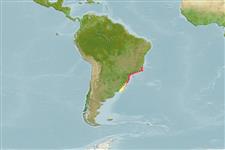Environment: milieu / climate zone / depth range / distribution range
Ecologia
marino associati a barriera corallina; distribuzione batimetrica 0 - ? m (Ref. 40849), usually 0 - 15 m (Ref. 40849). Subtropical; 20°S - 35°S
Western Atlantic: Southern Florida, (USA), Bahamas, Antilles, and coast of South America (Ref. 26938), from Brazil to Argentina (Ref. 3815).
Length at first maturity / Size / Peso / Age
Maturity: Lm 20.3, range 20 - 23.1 cm
Max length : 37.8 cm TL maschio/sesso non determinato; (Ref. 57473); peso massimo pubblicato: 2.5 kg (Ref. )
Spine dorsali (totale): 12; Raggi dorsali molli (totale): 13-14; Spine anali 3; Raggi anali molli: 12 - 14. Large, black, saddle-shaped blotch on upper caudal peduncle (Ref. 26938). Silvery, about nine faint narrow dark bars may be visible on upper two-thirds of body (Ref. 13442).
Occur in clean turbulent waters along open rocky coasts, usually in surf areas (Ref. 7251). Juveniles are frequently found in littoral pools between rocks (Ref. 9626). Individuals up to 10 cm are caught in shallow waters, often in sandy shores or in seagrass (Thalassia) beds (Ref. 9626). Maximum weight of 2500 g based on confirmed reports from Uruguay (L.A. Pereira, pers. comm., 6/12/01).
Life cycle and mating behavior
Maturità | Riproduzione | Deposizione | Uova | Fecundity | Larve
Cervigón, F., 1993. Los peces marinos de Venezuela. Volume 2. Fundación Científica Los Roques, Caracas,Venezuela. 497 p. (Ref. 9626)
IUCN Red List Status (Ref. 130435)
Threat to humans
Harmless
Human uses
Pesca: scarso interesse commerciale; Pesce da pesca sportiva: si
Informazioni ulteriori
BibliografiaAcquacolturaProfilo di acquacolturaVarietàGeneticaElectrophoresesEreditarietàMalattieElaborazioneNutrientsMass conversion
CollaboratoriImmaginiStamps, Coins Misc.SuoniCiguateraVelocitàModalità di nuotoArea branchialeOtolithsCervelliVista
Strumenti
Special reports
Download XML
Fonti Internet
Estimates based on models
Preferred temperature (Ref.
123201): 21.1 - 25.8, mean 23.4 °C (based on 68 cells).
Phylogenetic diversity index (Ref.
82804): PD
50 = 0.5000 [Uniqueness, from 0.5 = low to 2.0 = high].
Bayesian length-weight: a=0.01230 (0.00574 - 0.02638), b=3.04 (2.87 - 3.21), in cm total length, based on LWR estimates for this Genus-body shape (Ref.
93245).
Trophic level (Ref.
69278): 3.1 ±0.39 se; based on food items.
Resilienza (Ref.
120179): Medio, tempo minimo di raddoppiamento della popolazione 1.4 - 4.4 anni (Preliminary K or Fecundity.).
Fishing Vulnerability (Ref.
59153): Low to moderate vulnerability (28 of 100).
Climate Vulnerability (Ref.
125649): Moderate to high vulnerability (51 of 100).
Nutrients (Ref.
124155): Calcium = 34.1 [14.0, 57.1] mg/100g; Iron = 0.607 [0.319, 1.135] mg/100g; Protein = 20.2 [19.1, 21.3] %; Omega3 = 0.218 [0.116, 0.427] g/100g; Selenium = 15.9 [7.5, 29.7] μg/100g; VitaminA = 48.4 [14.4, 155.5] μg/100g; Zinc = 0.867 [0.571, 1.303] mg/100g (wet weight);
